Civil Engineering: Substructure and Superstructure Measurement Project
VerifiedAdded on 2023/04/24
|13
|2438
|450
Project
AI Summary
This document presents a comprehensive solution to a civil engineering project focused on the measurement of substructure and superstructure elements of a building. The project involves two main tasks: Task 1 requires the manual measurement of a selected building element (e.g., foundation, ground floor, or DPC) using traditional methods, including a detailed taking-off list, query sheet, and dimension paper. Task 2 involves the computerized measurement of a different building element using Cost-X software, presented professionally. The solution covers the key components of substructure, including foundations, ground floors, and damp-proof courses (DPC), as well as aspects of excavation, concrete mixing, and site leveling. The assignment adheres to NRM2 measurement standards and conventions, with a focus on accurate and reliable estimation practices. The solution also includes details on material properties, such as C20 concrete, and construction processes. The provided solution demonstrates the practical application of measurement techniques in civil engineering projects, ensuring accuracy and adherence to industry standards.
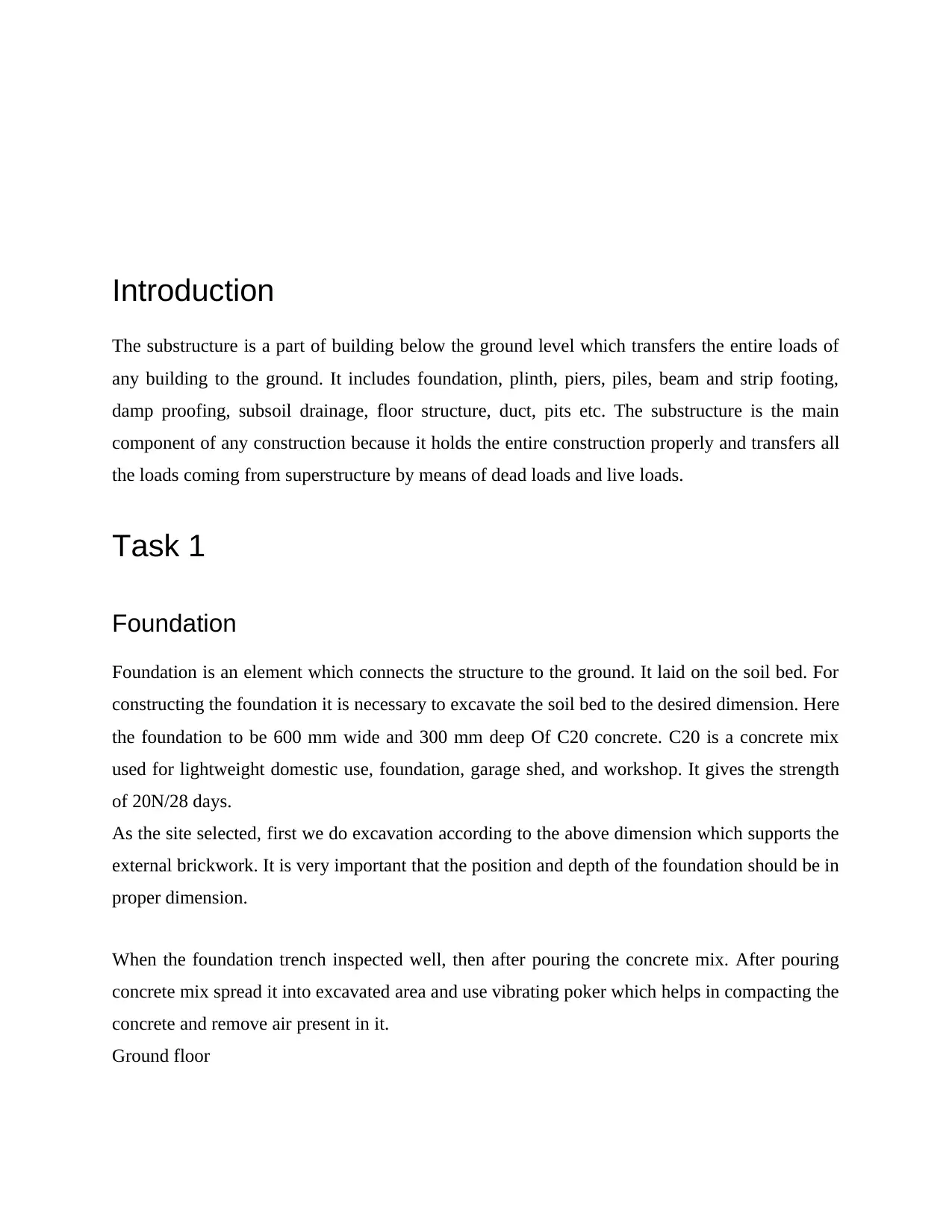
Introduction
The substructure is a part of building below the ground level which transfers the entire loads of
any building to the ground. It includes foundation, plinth, piers, piles, beam and strip footing,
damp proofing, subsoil drainage, floor structure, duct, pits etc. The substructure is the main
component of any construction because it holds the entire construction properly and transfers all
the loads coming from superstructure by means of dead loads and live loads.
Task 1
Foundation
Foundation is an element which connects the structure to the ground. It laid on the soil bed. For
constructing the foundation it is necessary to excavate the soil bed to the desired dimension. Here
the foundation to be 600 mm wide and 300 mm deep Of C20 concrete. C20 is a concrete mix
used for lightweight domestic use, foundation, garage shed, and workshop. It gives the strength
of 20N/28 days.
As the site selected, first we do excavation according to the above dimension which supports the
external brickwork. It is very important that the position and depth of the foundation should be in
proper dimension.
When the foundation trench inspected well, then after pouring the concrete mix. After pouring
concrete mix spread it into excavated area and use vibrating poker which helps in compacting the
concrete and remove air present in it.
Ground floor
The substructure is a part of building below the ground level which transfers the entire loads of
any building to the ground. It includes foundation, plinth, piers, piles, beam and strip footing,
damp proofing, subsoil drainage, floor structure, duct, pits etc. The substructure is the main
component of any construction because it holds the entire construction properly and transfers all
the loads coming from superstructure by means of dead loads and live loads.
Task 1
Foundation
Foundation is an element which connects the structure to the ground. It laid on the soil bed. For
constructing the foundation it is necessary to excavate the soil bed to the desired dimension. Here
the foundation to be 600 mm wide and 300 mm deep Of C20 concrete. C20 is a concrete mix
used for lightweight domestic use, foundation, garage shed, and workshop. It gives the strength
of 20N/28 days.
As the site selected, first we do excavation according to the above dimension which supports the
external brickwork. It is very important that the position and depth of the foundation should be in
proper dimension.
When the foundation trench inspected well, then after pouring the concrete mix. After pouring
concrete mix spread it into excavated area and use vibrating poker which helps in compacting the
concrete and remove air present in it.
Ground floor
Paraphrase This Document
Need a fresh take? Get an instant paraphrase of this document with our AI Paraphraser
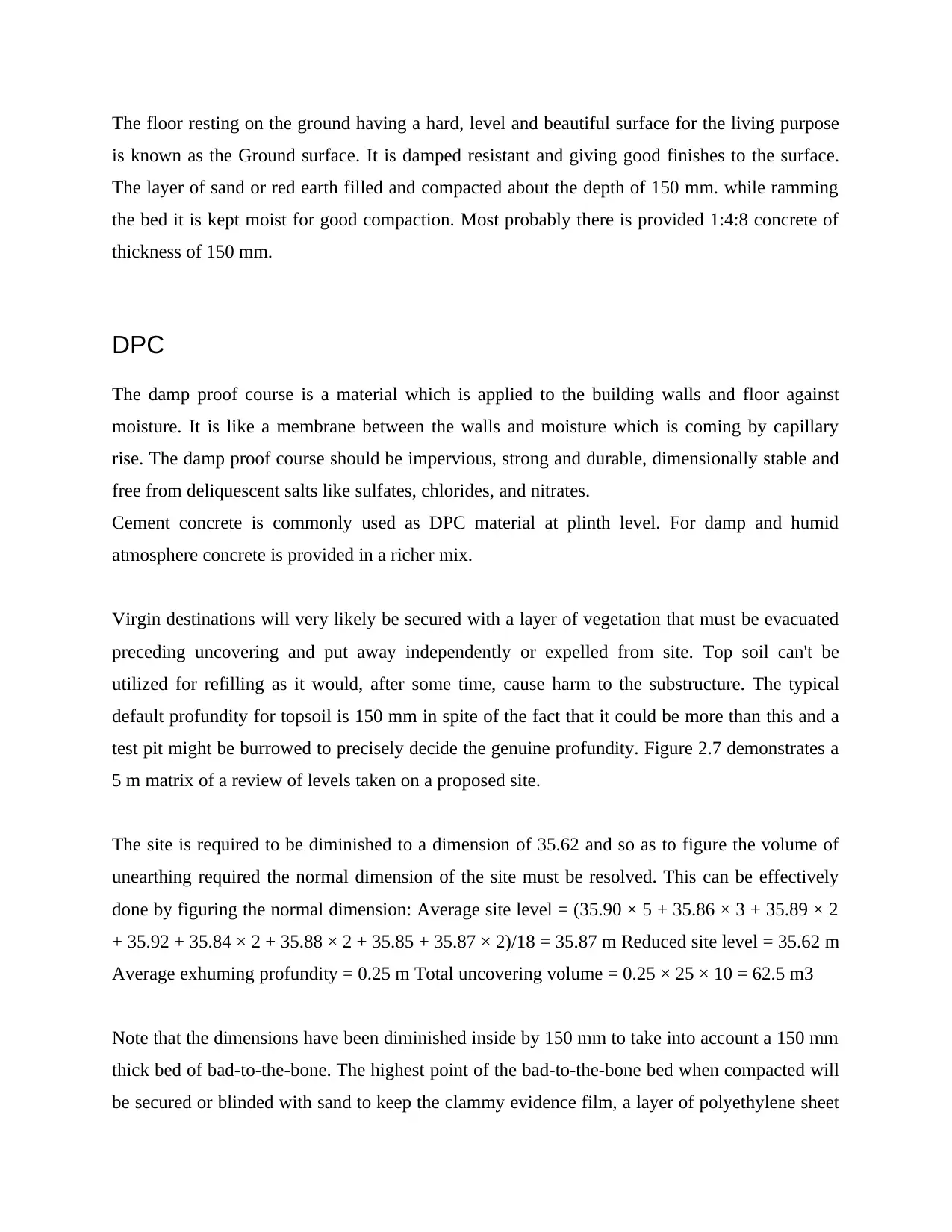
The floor resting on the ground having a hard, level and beautiful surface for the living purpose
is known as the Ground surface. It is damped resistant and giving good finishes to the surface.
The layer of sand or red earth filled and compacted about the depth of 150 mm. while ramming
the bed it is kept moist for good compaction. Most probably there is provided 1:4:8 concrete of
thickness of 150 mm.
DPC
The damp proof course is a material which is applied to the building walls and floor against
moisture. It is like a membrane between the walls and moisture which is coming by capillary
rise. The damp proof course should be impervious, strong and durable, dimensionally stable and
free from deliquescent salts like sulfates, chlorides, and nitrates.
Cement concrete is commonly used as DPC material at plinth level. For damp and humid
atmosphere concrete is provided in a richer mix.
Virgin destinations will very likely be secured with a layer of vegetation that must be evacuated
preceding uncovering and put away independently or expelled from site. Top soil can't be
utilized for refilling as it would, after some time, cause harm to the substructure. The typical
default profundity for topsoil is 150 mm in spite of the fact that it could be more than this and a
test pit might be burrowed to precisely decide the genuine profundity. Figure 2.7 demonstrates a
5 m matrix of a review of levels taken on a proposed site.
The site is required to be diminished to a dimension of 35.62 and so as to figure the volume of
unearthing required the normal dimension of the site must be resolved. This can be effectively
done by figuring the normal dimension: Average site level = (35.90 × 5 + 35.86 × 3 + 35.89 × 2
+ 35.92 + 35.84 × 2 + 35.88 × 2 + 35.85 + 35.87 × 2)/18 = 35.87 m Reduced site level = 35.62 m
Average exhuming profundity = 0.25 m Total uncovering volume = 0.25 × 25 × 10 = 62.5 m3
Note that the dimensions have been diminished inside by 150 mm to take into account a 150 mm
thick bed of bad-to-the-bone. The highest point of the bad-to-the-bone bed when compacted will
be secured or blinded with sand to keep the clammy evidence film, a layer of polyethylene sheet
is known as the Ground surface. It is damped resistant and giving good finishes to the surface.
The layer of sand or red earth filled and compacted about the depth of 150 mm. while ramming
the bed it is kept moist for good compaction. Most probably there is provided 1:4:8 concrete of
thickness of 150 mm.
DPC
The damp proof course is a material which is applied to the building walls and floor against
moisture. It is like a membrane between the walls and moisture which is coming by capillary
rise. The damp proof course should be impervious, strong and durable, dimensionally stable and
free from deliquescent salts like sulfates, chlorides, and nitrates.
Cement concrete is commonly used as DPC material at plinth level. For damp and humid
atmosphere concrete is provided in a richer mix.
Virgin destinations will very likely be secured with a layer of vegetation that must be evacuated
preceding uncovering and put away independently or expelled from site. Top soil can't be
utilized for refilling as it would, after some time, cause harm to the substructure. The typical
default profundity for topsoil is 150 mm in spite of the fact that it could be more than this and a
test pit might be burrowed to precisely decide the genuine profundity. Figure 2.7 demonstrates a
5 m matrix of a review of levels taken on a proposed site.
The site is required to be diminished to a dimension of 35.62 and so as to figure the volume of
unearthing required the normal dimension of the site must be resolved. This can be effectively
done by figuring the normal dimension: Average site level = (35.90 × 5 + 35.86 × 3 + 35.89 × 2
+ 35.92 + 35.84 × 2 + 35.88 × 2 + 35.85 + 35.87 × 2)/18 = 35.87 m Reduced site level = 35.62 m
Average exhuming profundity = 0.25 m Total uncovering volume = 0.25 × 25 × 10 = 62.5 m3
Note that the dimensions have been diminished inside by 150 mm to take into account a 150 mm
thick bed of bad-to-the-bone. The highest point of the bad-to-the-bone bed when compacted will
be secured or blinded with sand to keep the clammy evidence film, a layer of polyethylene sheet
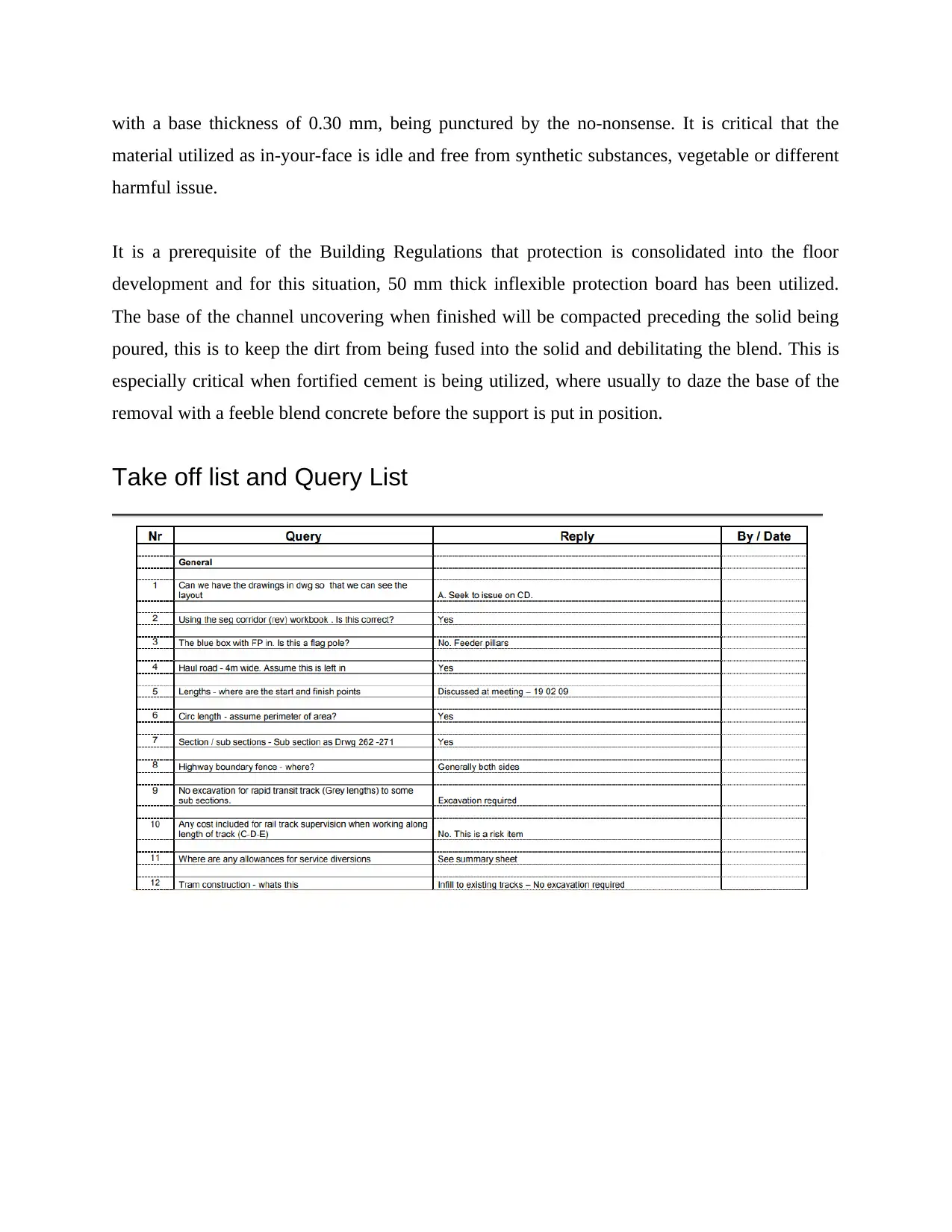
with a base thickness of 0.30 mm, being punctured by the no-nonsense. It is critical that the
material utilized as in-your-face is idle and free from synthetic substances, vegetable or different
harmful issue.
It is a prerequisite of the Building Regulations that protection is consolidated into the floor
development and for this situation, 50 mm thick inflexible protection board has been utilized.
The base of the channel uncovering when finished will be compacted preceding the solid being
poured, this is to keep the dirt from being fused into the solid and debilitating the blend. This is
especially critical when fortified cement is being utilized, where usually to daze the base of the
removal with a feeble blend concrete before the support is put in position.
Take off list and Query List
material utilized as in-your-face is idle and free from synthetic substances, vegetable or different
harmful issue.
It is a prerequisite of the Building Regulations that protection is consolidated into the floor
development and for this situation, 50 mm thick inflexible protection board has been utilized.
The base of the channel uncovering when finished will be compacted preceding the solid being
poured, this is to keep the dirt from being fused into the solid and debilitating the blend. This is
especially critical when fortified cement is being utilized, where usually to daze the base of the
removal with a feeble blend concrete before the support is put in position.
Take off list and Query List
⊘ This is a preview!⊘
Do you want full access?
Subscribe today to unlock all pages.

Trusted by 1+ million students worldwide
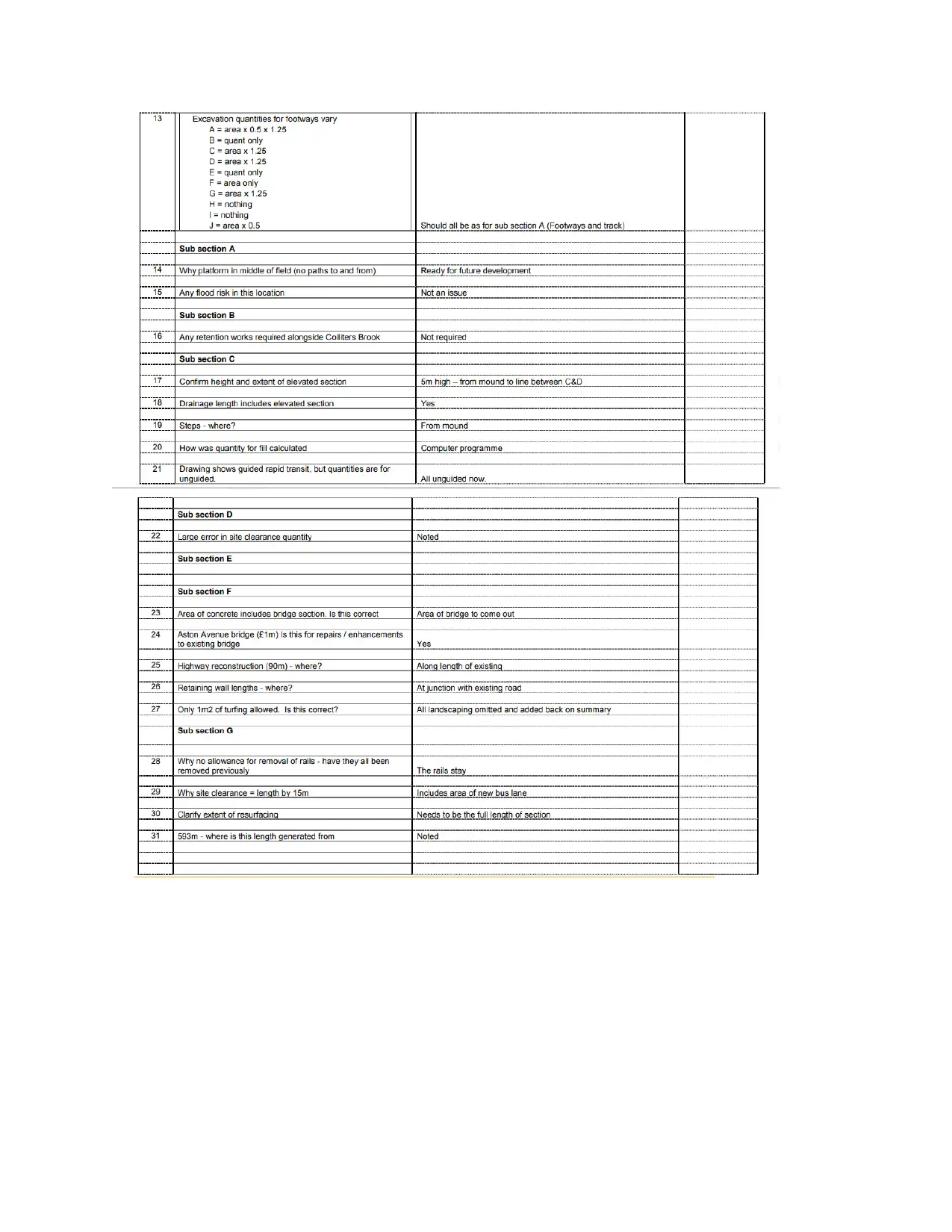
Paraphrase This Document
Need a fresh take? Get an instant paraphrase of this document with our AI Paraphraser
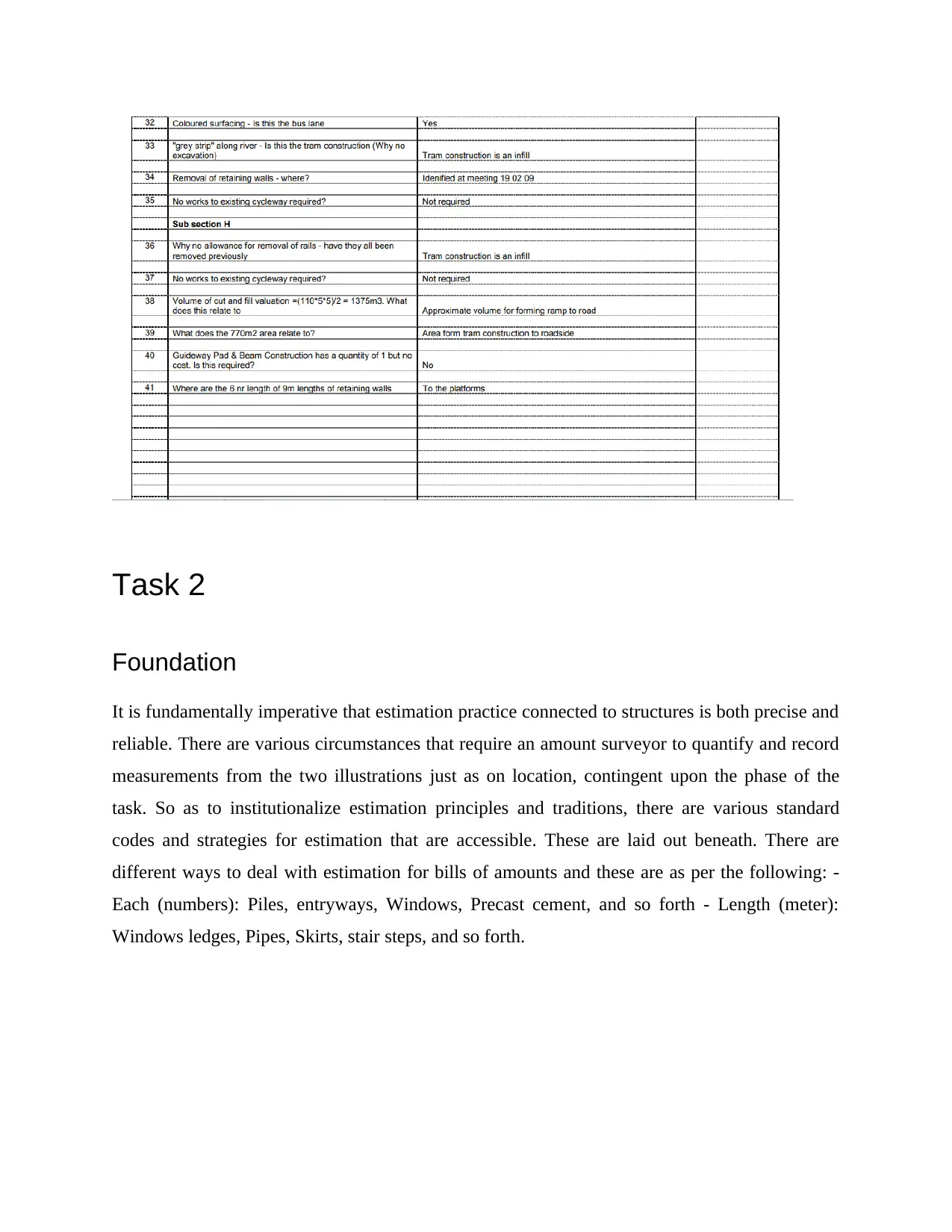
Task 2
Foundation
It is fundamentally imperative that estimation practice connected to structures is both precise and
reliable. There are various circumstances that require an amount surveyor to quantify and record
measurements from the two illustrations just as on location, contingent upon the phase of the
task. So as to institutionalize estimation principles and traditions, there are various standard
codes and strategies for estimation that are accessible. These are laid out beneath. There are
different ways to deal with estimation for bills of amounts and these are as per the following: -
Each (numbers): Piles, entryways, Windows, Precast cement, and so forth - Length (meter):
Windows ledges, Pipes, Skirts, stair steps, and so forth.
Foundation
It is fundamentally imperative that estimation practice connected to structures is both precise and
reliable. There are various circumstances that require an amount surveyor to quantify and record
measurements from the two illustrations just as on location, contingent upon the phase of the
task. So as to institutionalize estimation principles and traditions, there are various standard
codes and strategies for estimation that are accessible. These are laid out beneath. There are
different ways to deal with estimation for bills of amounts and these are as per the following: -
Each (numbers): Piles, entryways, Windows, Precast cement, and so forth - Length (meter):
Windows ledges, Pipes, Skirts, stair steps, and so forth.
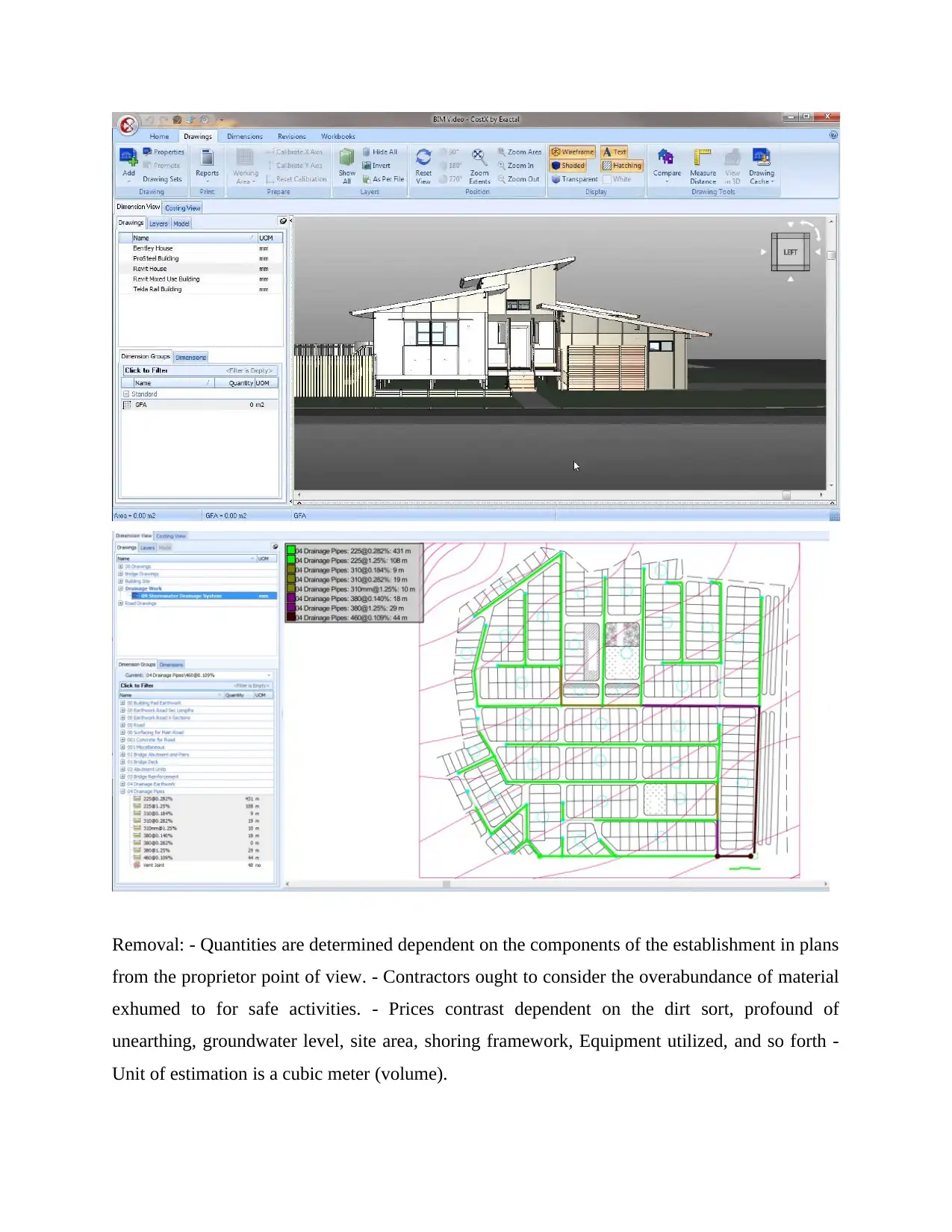
Removal: - Quantities are determined dependent on the components of the establishment in plans
from the proprietor point of view. - Contractors ought to consider the overabundance of material
exhumed to for safe activities. - Prices contrast dependent on the dirt sort, profound of
unearthing, groundwater level, site area, shoring framework, Equipment utilized, and so forth -
Unit of estimation is a cubic meter (volume).
from the proprietor point of view. - Contractors ought to consider the overabundance of material
exhumed to for safe activities. - Prices contrast dependent on the dirt sort, profound of
unearthing, groundwater level, site area, shoring framework, Equipment utilized, and so forth -
Unit of estimation is a cubic meter (volume).
⊘ This is a preview!⊘
Do you want full access?
Subscribe today to unlock all pages.

Trusted by 1+ million students worldwide
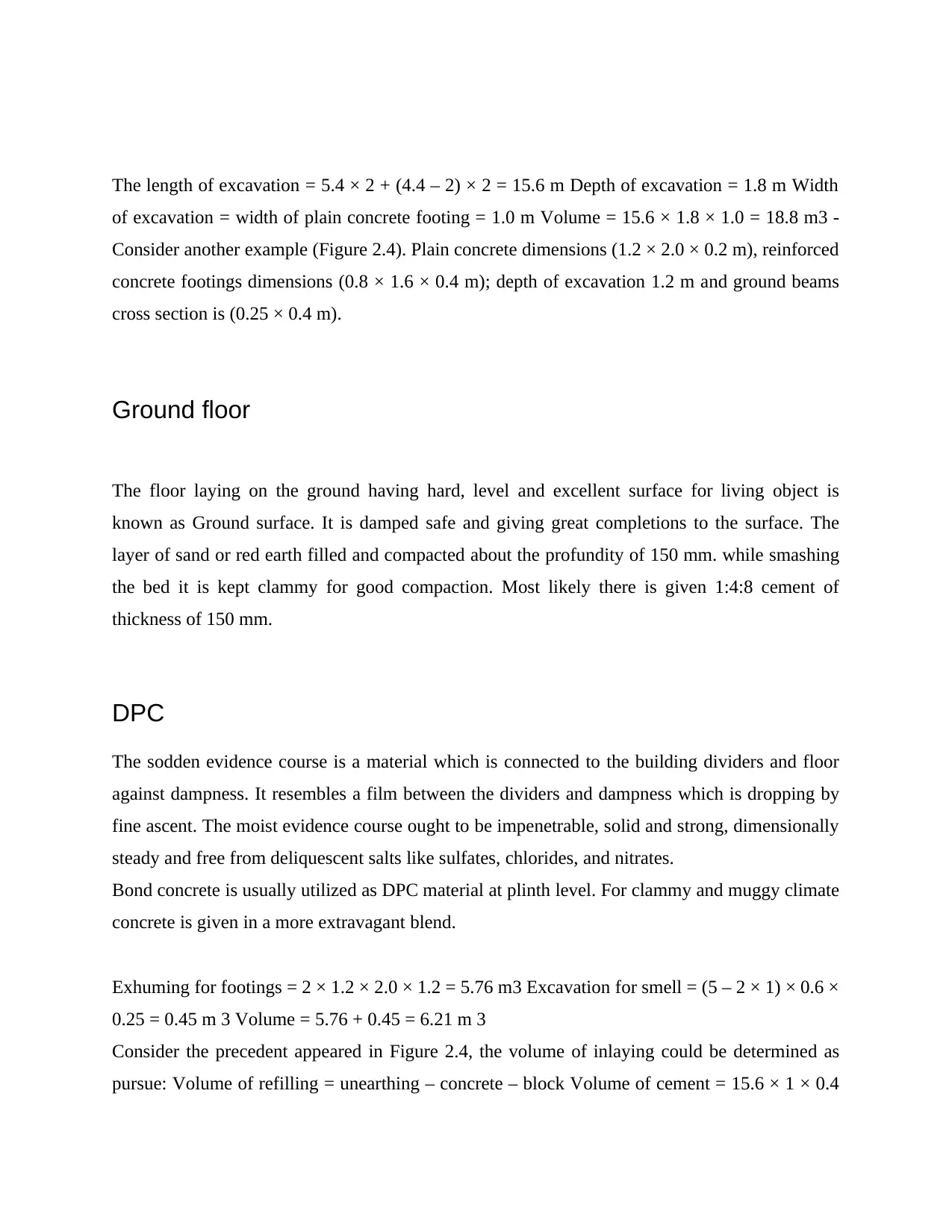
The length of excavation = 5.4 × 2 + (4.4 – 2) × 2 = 15.6 m Depth of excavation = 1.8 m Width
of excavation = width of plain concrete footing = 1.0 m Volume = 15.6 × 1.8 × 1.0 = 18.8 m3 -
Consider another example (Figure 2.4). Plain concrete dimensions (1.2 × 2.0 × 0.2 m), reinforced
concrete footings dimensions (0.8 × 1.6 × 0.4 m); depth of excavation 1.2 m and ground beams
cross section is (0.25 × 0.4 m).
Ground floor
The floor laying on the ground having hard, level and excellent surface for living object is
known as Ground surface. It is damped safe and giving great completions to the surface. The
layer of sand or red earth filled and compacted about the profundity of 150 mm. while smashing
the bed it is kept clammy for good compaction. Most likely there is given 1:4:8 cement of
thickness of 150 mm.
DPC
The sodden evidence course is a material which is connected to the building dividers and floor
against dampness. It resembles a film between the dividers and dampness which is dropping by
fine ascent. The moist evidence course ought to be impenetrable, solid and strong, dimensionally
steady and free from deliquescent salts like sulfates, chlorides, and nitrates.
Bond concrete is usually utilized as DPC material at plinth level. For clammy and muggy climate
concrete is given in a more extravagant blend.
Exhuming for footings = 2 × 1.2 × 2.0 × 1.2 = 5.76 m3 Excavation for smell = (5 – 2 × 1) × 0.6 ×
0.25 = 0.45 m 3 Volume = 5.76 + 0.45 = 6.21 m 3
Consider the precedent appeared in Figure 2.4, the volume of inlaying could be determined as
pursue: Volume of refilling = unearthing – concrete – block Volume of cement = 15.6 × 1 × 0.4
of excavation = width of plain concrete footing = 1.0 m Volume = 15.6 × 1.8 × 1.0 = 18.8 m3 -
Consider another example (Figure 2.4). Plain concrete dimensions (1.2 × 2.0 × 0.2 m), reinforced
concrete footings dimensions (0.8 × 1.6 × 0.4 m); depth of excavation 1.2 m and ground beams
cross section is (0.25 × 0.4 m).
Ground floor
The floor laying on the ground having hard, level and excellent surface for living object is
known as Ground surface. It is damped safe and giving great completions to the surface. The
layer of sand or red earth filled and compacted about the profundity of 150 mm. while smashing
the bed it is kept clammy for good compaction. Most likely there is given 1:4:8 cement of
thickness of 150 mm.
DPC
The sodden evidence course is a material which is connected to the building dividers and floor
against dampness. It resembles a film between the dividers and dampness which is dropping by
fine ascent. The moist evidence course ought to be impenetrable, solid and strong, dimensionally
steady and free from deliquescent salts like sulfates, chlorides, and nitrates.
Bond concrete is usually utilized as DPC material at plinth level. For clammy and muggy climate
concrete is given in a more extravagant blend.
Exhuming for footings = 2 × 1.2 × 2.0 × 1.2 = 5.76 m3 Excavation for smell = (5 – 2 × 1) × 0.6 ×
0.25 = 0.45 m 3 Volume = 5.76 + 0.45 = 6.21 m 3
Consider the precedent appeared in Figure 2.4, the volume of inlaying could be determined as
pursue: Volume of refilling = unearthing – concrete – block Volume of cement = 15.6 × 1 × 0.4
Paraphrase This Document
Need a fresh take? Get an instant paraphrase of this document with our AI Paraphraser
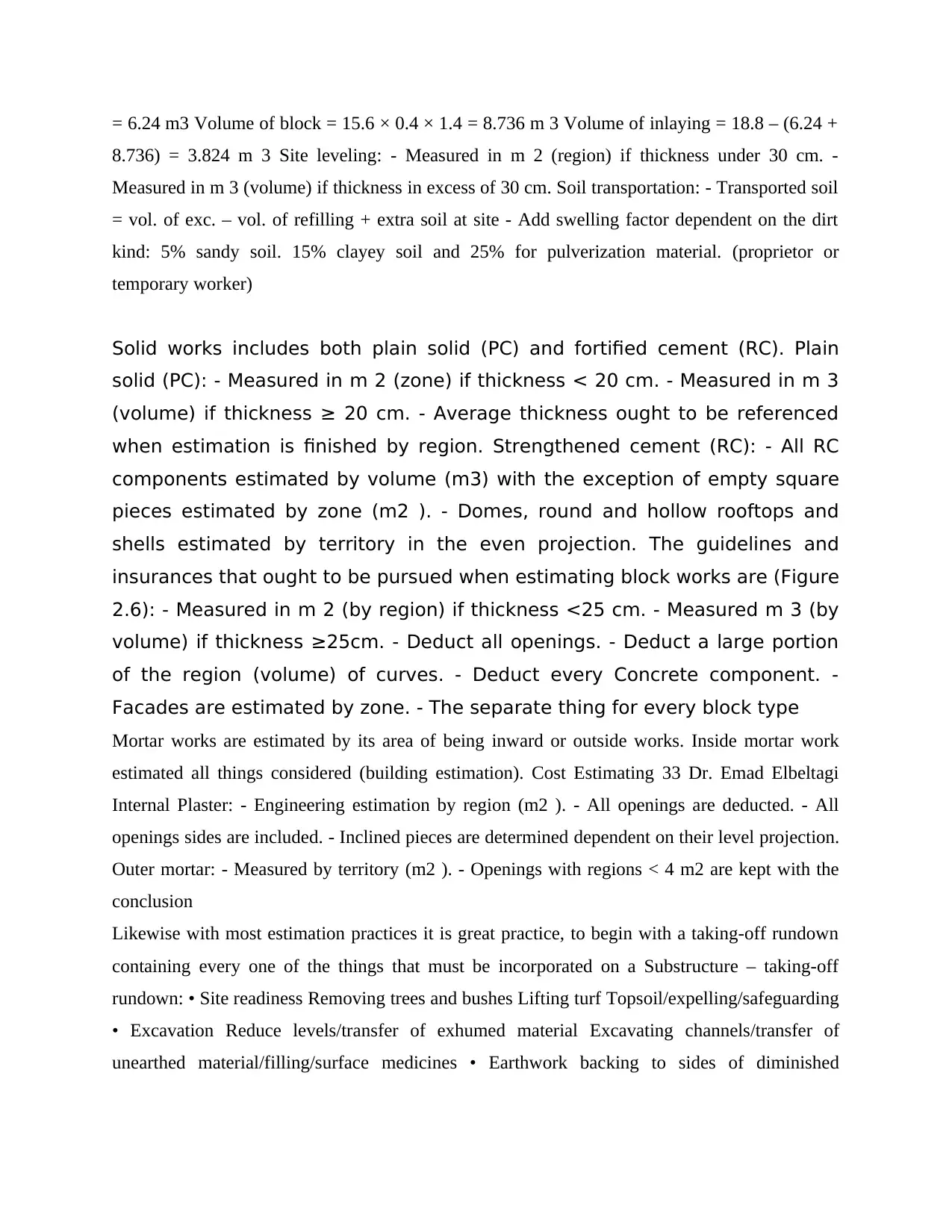
= 6.24 m3 Volume of block = 15.6 × 0.4 × 1.4 = 8.736 m 3 Volume of inlaying = 18.8 – (6.24 +
8.736) = 3.824 m 3 Site leveling: - Measured in m 2 (region) if thickness under 30 cm. -
Measured in m 3 (volume) if thickness in excess of 30 cm. Soil transportation: - Transported soil
= vol. of exc. – vol. of refilling + extra soil at site - Add swelling factor dependent on the dirt
kind: 5% sandy soil. 15% clayey soil and 25% for pulverization material. (proprietor or
temporary worker)
Solid works includes both plain solid (PC) and fortified cement (RC). Plain
solid (PC): - Measured in m 2 (zone) if thickness < 20 cm. - Measured in m 3
(volume) if thickness ≥ 20 cm. - Average thickness ought to be referenced
when estimation is finished by region. Strengthened cement (RC): - All RC
components estimated by volume (m3) with the exception of empty square
pieces estimated by zone (m2 ). - Domes, round and hollow rooftops and
shells estimated by territory in the even projection. The guidelines and
insurances that ought to be pursued when estimating block works are (Figure
2.6): - Measured in m 2 (by region) if thickness <25 cm. - Measured m 3 (by
volume) if thickness ≥25cm. - Deduct all openings. - Deduct a large portion
of the region (volume) of curves. - Deduct every Concrete component. -
Facades are estimated by zone. - The separate thing for every block type
Mortar works are estimated by its area of being inward or outside works. Inside mortar work
estimated all things considered (building estimation). Cost Estimating 33 Dr. Emad Elbeltagi
Internal Plaster: - Engineering estimation by region (m2 ). - All openings are deducted. - All
openings sides are included. - Inclined pieces are determined dependent on their level projection.
Outer mortar: - Measured by territory (m2 ). - Openings with regions < 4 m2 are kept with the
conclusion
Likewise with most estimation practices it is great practice, to begin with a taking-off rundown
containing every one of the things that must be incorporated on a Substructure – taking-off
rundown: • Site readiness Removing trees and bushes Lifting turf Topsoil/expelling/safeguarding
• Excavation Reduce levels/transfer of exhumed material Excavating channels/transfer of
unearthed material/filling/surface medicines • Earthwork backing to sides of diminished
8.736) = 3.824 m 3 Site leveling: - Measured in m 2 (region) if thickness under 30 cm. -
Measured in m 3 (volume) if thickness in excess of 30 cm. Soil transportation: - Transported soil
= vol. of exc. – vol. of refilling + extra soil at site - Add swelling factor dependent on the dirt
kind: 5% sandy soil. 15% clayey soil and 25% for pulverization material. (proprietor or
temporary worker)
Solid works includes both plain solid (PC) and fortified cement (RC). Plain
solid (PC): - Measured in m 2 (zone) if thickness < 20 cm. - Measured in m 3
(volume) if thickness ≥ 20 cm. - Average thickness ought to be referenced
when estimation is finished by region. Strengthened cement (RC): - All RC
components estimated by volume (m3) with the exception of empty square
pieces estimated by zone (m2 ). - Domes, round and hollow rooftops and
shells estimated by territory in the even projection. The guidelines and
insurances that ought to be pursued when estimating block works are (Figure
2.6): - Measured in m 2 (by region) if thickness <25 cm. - Measured m 3 (by
volume) if thickness ≥25cm. - Deduct all openings. - Deduct a large portion
of the region (volume) of curves. - Deduct every Concrete component. -
Facades are estimated by zone. - The separate thing for every block type
Mortar works are estimated by its area of being inward or outside works. Inside mortar work
estimated all things considered (building estimation). Cost Estimating 33 Dr. Emad Elbeltagi
Internal Plaster: - Engineering estimation by region (m2 ). - All openings are deducted. - All
openings sides are included. - Inclined pieces are determined dependent on their level projection.
Outer mortar: - Measured by territory (m2 ). - Openings with regions < 4 m2 are kept with the
conclusion
Likewise with most estimation practices it is great practice, to begin with a taking-off rundown
containing every one of the things that must be incorporated on a Substructure – taking-off
rundown: • Site readiness Removing trees and bushes Lifting turf Topsoil/expelling/safeguarding
• Excavation Reduce levels/transfer of exhumed material Excavating channels/transfer of
unearthed material/filling/surface medicines • Earthwork backing to sides of diminished
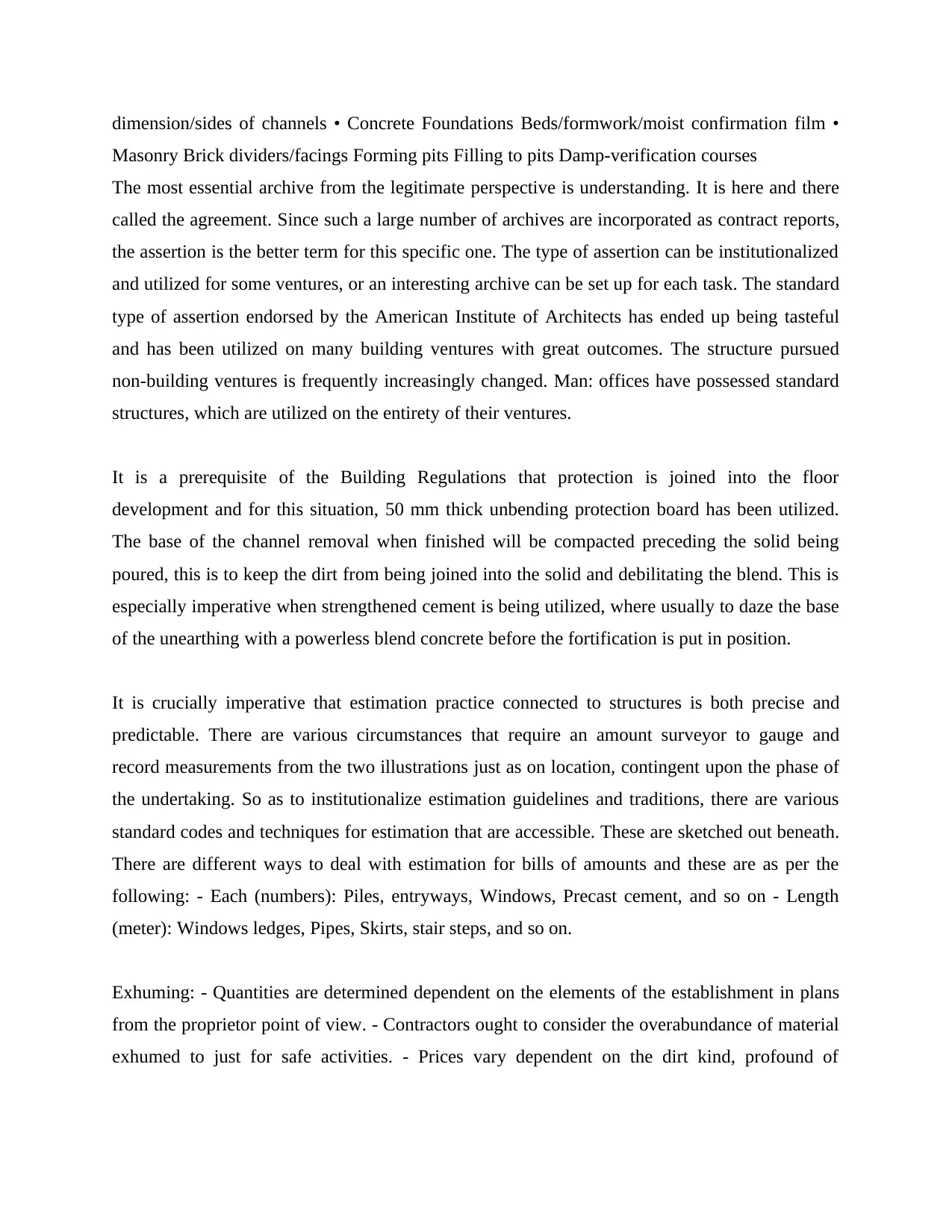
dimension/sides of channels • Concrete Foundations Beds/formwork/moist confirmation film •
Masonry Brick dividers/facings Forming pits Filling to pits Damp-verification courses
The most essential archive from the legitimate perspective is understanding. It is here and there
called the agreement. Since such a large number of archives are incorporated as contract reports,
the assertion is the better term for this specific one. The type of assertion can be institutionalized
and utilized for some ventures, or an interesting archive can be set up for each task. The standard
type of assertion endorsed by the American Institute of Architects has ended up being tasteful
and has been utilized on many building ventures with great outcomes. The structure pursued
non-building ventures is frequently increasingly changed. Man: offices have possessed standard
structures, which are utilized on the entirety of their ventures.
It is a prerequisite of the Building Regulations that protection is joined into the floor
development and for this situation, 50 mm thick unbending protection board has been utilized.
The base of the channel removal when finished will be compacted preceding the solid being
poured, this is to keep the dirt from being joined into the solid and debilitating the blend. This is
especially imperative when strengthened cement is being utilized, where usually to daze the base
of the unearthing with a powerless blend concrete before the fortification is put in position.
It is crucially imperative that estimation practice connected to structures is both precise and
predictable. There are various circumstances that require an amount surveyor to gauge and
record measurements from the two illustrations just as on location, contingent upon the phase of
the undertaking. So as to institutionalize estimation guidelines and traditions, there are various
standard codes and techniques for estimation that are accessible. These are sketched out beneath.
There are different ways to deal with estimation for bills of amounts and these are as per the
following: - Each (numbers): Piles, entryways, Windows, Precast cement, and so on - Length
(meter): Windows ledges, Pipes, Skirts, stair steps, and so on.
Exhuming: - Quantities are determined dependent on the elements of the establishment in plans
from the proprietor point of view. - Contractors ought to consider the overabundance of material
exhumed to just for safe activities. - Prices vary dependent on the dirt kind, profound of
Masonry Brick dividers/facings Forming pits Filling to pits Damp-verification courses
The most essential archive from the legitimate perspective is understanding. It is here and there
called the agreement. Since such a large number of archives are incorporated as contract reports,
the assertion is the better term for this specific one. The type of assertion can be institutionalized
and utilized for some ventures, or an interesting archive can be set up for each task. The standard
type of assertion endorsed by the American Institute of Architects has ended up being tasteful
and has been utilized on many building ventures with great outcomes. The structure pursued
non-building ventures is frequently increasingly changed. Man: offices have possessed standard
structures, which are utilized on the entirety of their ventures.
It is a prerequisite of the Building Regulations that protection is joined into the floor
development and for this situation, 50 mm thick unbending protection board has been utilized.
The base of the channel removal when finished will be compacted preceding the solid being
poured, this is to keep the dirt from being joined into the solid and debilitating the blend. This is
especially imperative when strengthened cement is being utilized, where usually to daze the base
of the unearthing with a powerless blend concrete before the fortification is put in position.
It is crucially imperative that estimation practice connected to structures is both precise and
predictable. There are various circumstances that require an amount surveyor to gauge and
record measurements from the two illustrations just as on location, contingent upon the phase of
the undertaking. So as to institutionalize estimation guidelines and traditions, there are various
standard codes and techniques for estimation that are accessible. These are sketched out beneath.
There are different ways to deal with estimation for bills of amounts and these are as per the
following: - Each (numbers): Piles, entryways, Windows, Precast cement, and so on - Length
(meter): Windows ledges, Pipes, Skirts, stair steps, and so on.
Exhuming: - Quantities are determined dependent on the elements of the establishment in plans
from the proprietor point of view. - Contractors ought to consider the overabundance of material
exhumed to just for safe activities. - Prices vary dependent on the dirt kind, profound of
⊘ This is a preview!⊘
Do you want full access?
Subscribe today to unlock all pages.

Trusted by 1+ million students worldwide
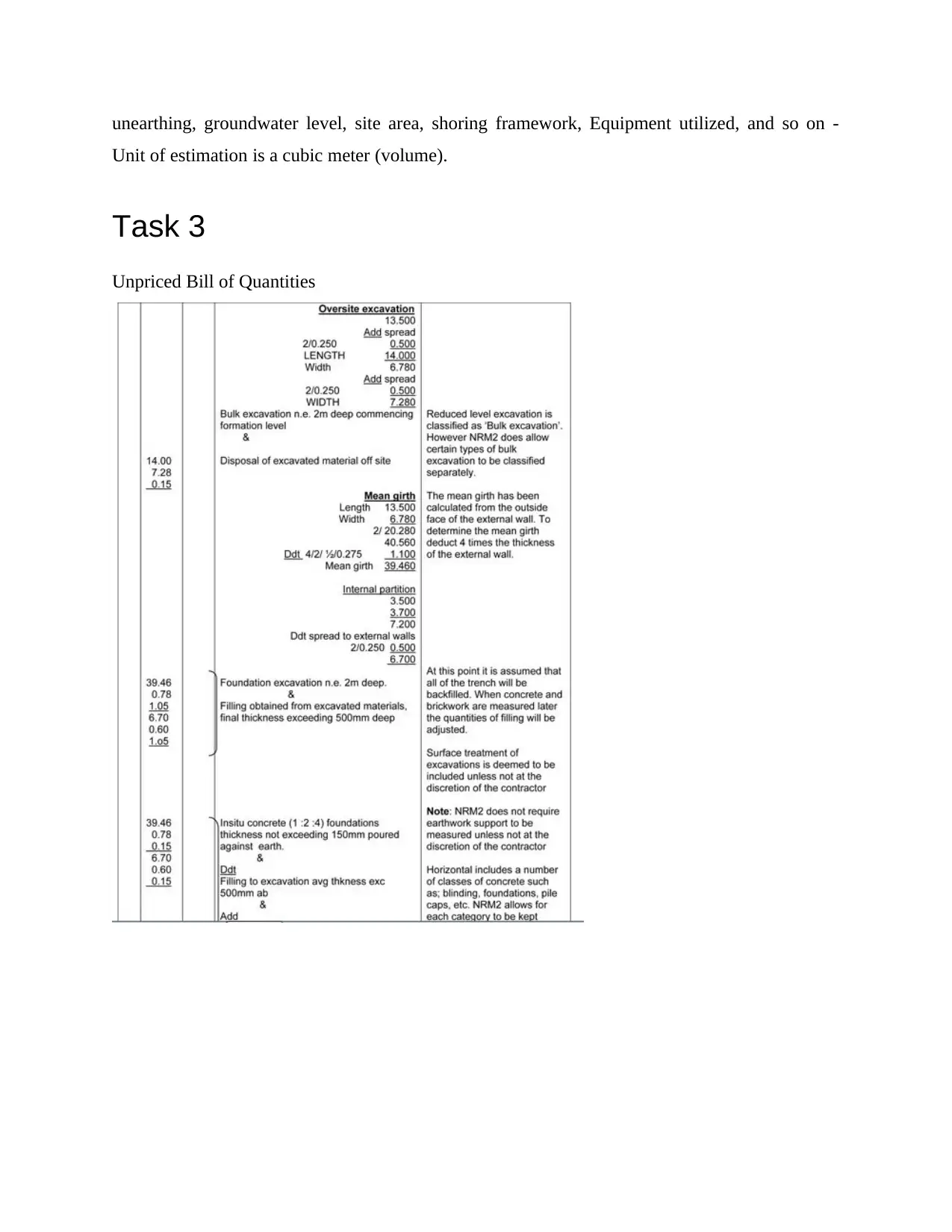
unearthing, groundwater level, site area, shoring framework, Equipment utilized, and so on -
Unit of estimation is a cubic meter (volume).
Task 3
Unpriced Bill of Quantities
Unit of estimation is a cubic meter (volume).
Task 3
Unpriced Bill of Quantities
Paraphrase This Document
Need a fresh take? Get an instant paraphrase of this document with our AI Paraphraser
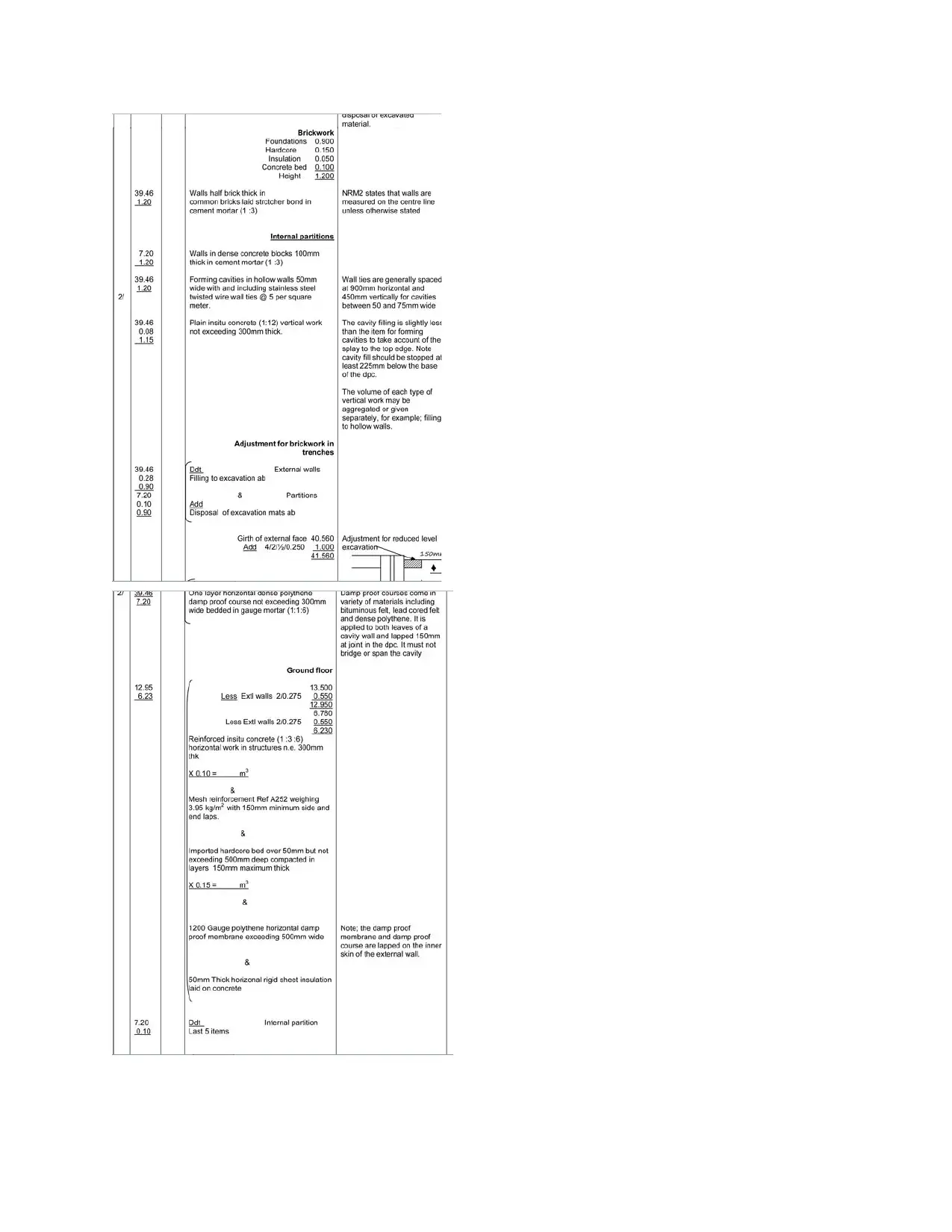
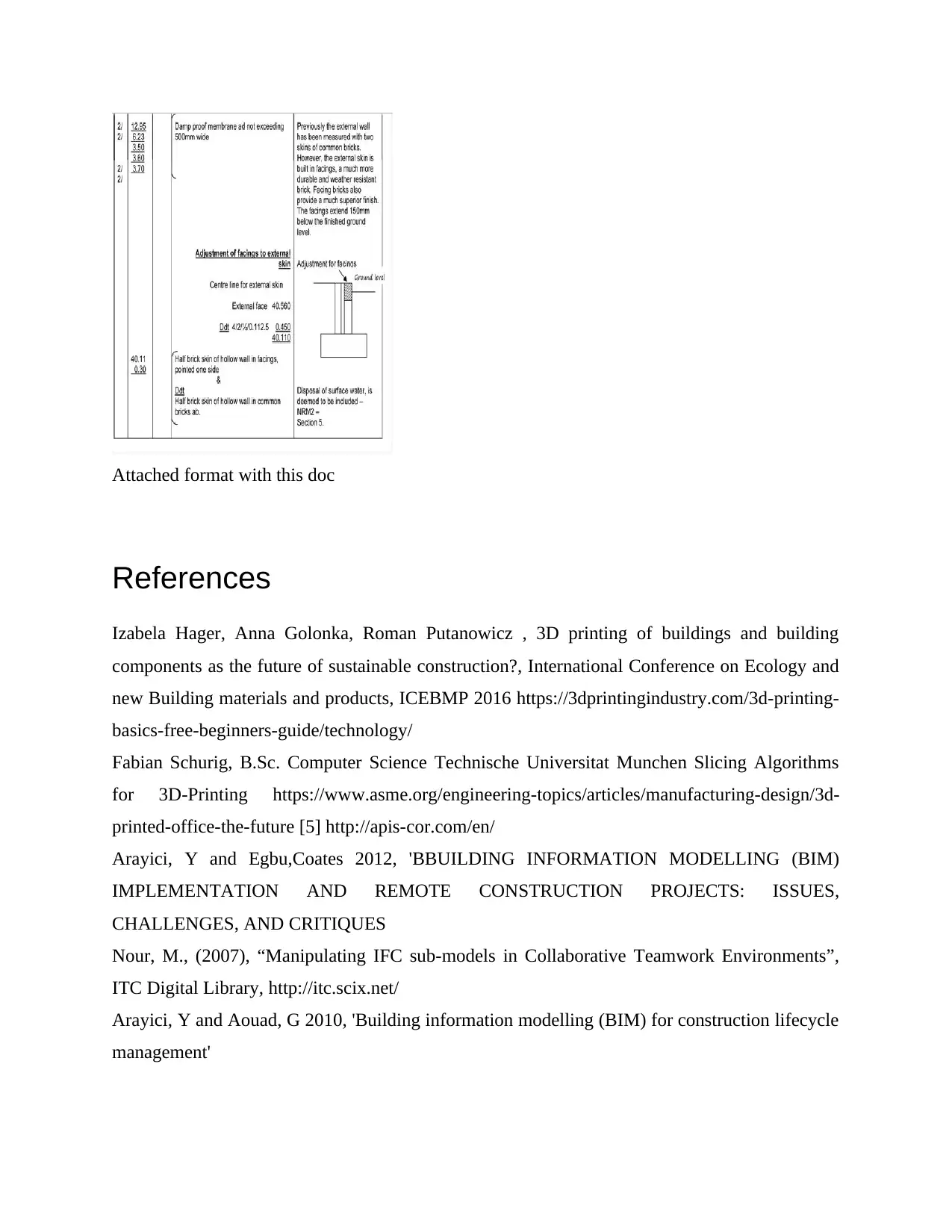
Attached format with this doc
References
Izabela Hager, Anna Golonka, Roman Putanowicz , 3D printing of buildings and building
components as the future of sustainable construction?, International Conference on Ecology and
new Building materials and products, ICEBMP 2016 https://3dprintingindustry.com/3d-printing-
basics-free-beginners-guide/technology/
Fabian Schurig, B.Sc. Computer Science Technische Universitat Munchen Slicing Algorithms
for 3D-Printing https://www.asme.org/engineering-topics/articles/manufacturing-design/3d-
printed-office-the-future [5] http://apis-cor.com/en/
Arayici, Y and Egbu,Coates 2012, 'BBUILDING INFORMATION MODELLING (BIM)
IMPLEMENTATION AND REMOTE CONSTRUCTION PROJECTS: ISSUES,
CHALLENGES, AND CRITIQUES
Nour, M., (2007), “Manipulating IFC sub-models in Collaborative Teamwork Environments”,
ITC Digital Library, http://itc.scix.net/
Arayici, Y and Aouad, G 2010, 'Building information modelling (BIM) for construction lifecycle
management'
References
Izabela Hager, Anna Golonka, Roman Putanowicz , 3D printing of buildings and building
components as the future of sustainable construction?, International Conference on Ecology and
new Building materials and products, ICEBMP 2016 https://3dprintingindustry.com/3d-printing-
basics-free-beginners-guide/technology/
Fabian Schurig, B.Sc. Computer Science Technische Universitat Munchen Slicing Algorithms
for 3D-Printing https://www.asme.org/engineering-topics/articles/manufacturing-design/3d-
printed-office-the-future [5] http://apis-cor.com/en/
Arayici, Y and Egbu,Coates 2012, 'BBUILDING INFORMATION MODELLING (BIM)
IMPLEMENTATION AND REMOTE CONSTRUCTION PROJECTS: ISSUES,
CHALLENGES, AND CRITIQUES
Nour, M., (2007), “Manipulating IFC sub-models in Collaborative Teamwork Environments”,
ITC Digital Library, http://itc.scix.net/
Arayici, Y and Aouad, G 2010, 'Building information modelling (BIM) for construction lifecycle
management'
⊘ This is a preview!⊘
Do you want full access?
Subscribe today to unlock all pages.

Trusted by 1+ million students worldwide
1 out of 13
Your All-in-One AI-Powered Toolkit for Academic Success.
+13062052269
info@desklib.com
Available 24*7 on WhatsApp / Email
![[object Object]](/_next/static/media/star-bottom.7253800d.svg)
Unlock your academic potential
Copyright © 2020–2025 A2Z Services. All Rights Reserved. Developed and managed by ZUCOL.


